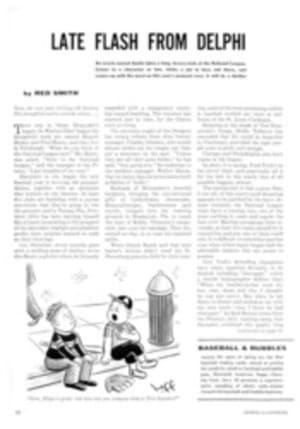
TRICK KNEE
Laceration of the meniscus—medical jargon for what everyone else knows better as "trick knee"—plagues most sports and worries many sportsmen. It can occur when playing football or basketball, skiing or bowling, or, for that matter, when simply stepping out of a shower. But however it happens, a trick knee needn't throw you.
ONE-WAY HINGE
Basically the knee is a self-lubricating, one-way hinge that connects the longest bones of the body, the thigh (femur) and lower leg (tibia). It is the most vulnerable joint in the anatomy to injury. Between the hard, irregular ends of the femur and tibia lie two half-moon-shaped bits of cartilage (menisci) which act as shock absorbers to cushion the bones. Six tough bands of ligaments hold the bones from slipping out of alignment, while a collarlike sac of fluid envelops the entire joint to keep the parts well oiled.
CAUSE-EFFECT
Normally, the knee can stand up to considerable punishment. But under certain circumstances, it buckles like cardboard. For example, a charging halfback is blocked or tackled at the knee and crashes to the ground. A basketball player fakes, spins to shoot and slips to the floor. A housewife gingerly steps off a ladder, twists around and her knee gives way. In each case the entire body weight rests on one foot—if only for a split second. Yet in that brief moment the leg is rotated inward, either by an outside blow or by the individual himself turning suddenly. In nine out of 10 injuries the cartilage or the ligament on the inner side of the knee is torn or jerked from its moorings with a resounding "pop." Whether it's for the first time or the 500th, the knee may painfully "lock." It's like wedging a piece of wood in the doorjamb; the door can't close. In the case of the knee, the misplaced cartilage jams the joint. As a result, the lining of the joint will often produce excessive lubricating fluid in attempting to overcome the irritation—a condition called "water on the knee." Ordinarily, massage or manipulation works the loose cartilage back into place, and the pain and swelling can be controlled by applying ice packs followed by heat.
REMEDY
While there is no sure way to avoid a trick knee, several precautions may make you less anxious about injury. The best protection, when playing any sport which requires quick, twisting movement, is to wear an Ace bandage, an elastic strip which can be cinched tight to support the joint. Another safeguard is to build up the quadriceps, the large muscle down the front of the thigh. One daily exercise is to sit on the edge of a table and slowly lift the leg up and down with increasing amounts of weight. (Although a normal leg can lift 100-130 pounds, you'd better start slow—say with a one-pound sack of salt or sugar.) Treatment of trick knee itself varies with each doctor. Most immobilize the knee in a cast, but many orthopedic specialists now believe that this leaves the joint stiff. An elastic bandage or strapping, they find, works better. As to surgery, if done by a qualified specialist, four out of five patients are back on their feet in short order.
FIVE ILLUSTRATIONS

